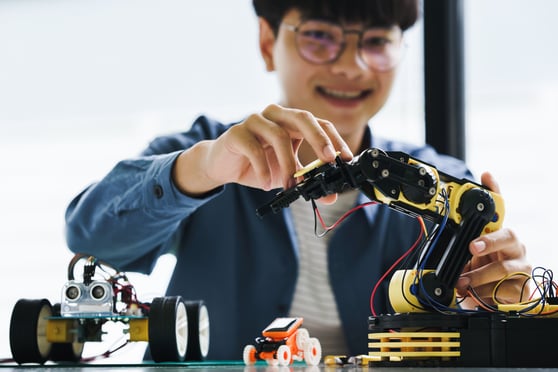
5 Easy Math Engagement Strategies for the Classroom
The news headlines are daunting. Math scores are down. School districts are scrambling to turn things around. And...
ALI Staff | Published November 13, 2023
The goal of modern education is crystal clear: to ignite students' passion for learning and sustain their interest in expanding knowledge. This is especially true for STEM, where interest can lead to successful and lucrative careers centered around a passion.
Let's explore different ways to make engineering come alive in the classroom by leveraging technology to enhance students' learning experience and adapting teaching methods to suit different age groups.
All of this will help provide students with the foundational skills they need to become the problem-solvers and innovators of tomorrow.

In today's classrooms, STEM isn't simply an acronym for Science, Technology, Engineering, and Mathematics; it represents a teaching approach that weaves these subjects together.
This educational strategy promotes a hands-on way of learning, pushing students to think critically and apply a mix of scientific concepts and practical design skills.
Engineering plays a crucial role in this approach, applying these theories to create real-world solutions.
For students to fully appreciate the engineering field, they must be exposed to its vast range—from the building of infrastructure to the development of software—and understand its significant impact on our everyday existence and the progress we will see in the future.
21st-century learning represents a significant shift from traditional education methods, emphasizing skills that align with the demands of a fast-paced, digital world. Here are some aspects of 21st-century learning:
21st-century learning is more than just a way to deliver information. It equips students with a broad range of skills essential for their future success and active participation in society.
Teaching engineering concepts effectively calls for using innovative educational methodologies such as inquiry-based, project-based, or interdisciplinary learning.
Interdisciplinary Approach:
Incorporating technology into engineering education transforms how students grasp complex concepts and engage with real-world problems.
For instance, CAD (Computer-Aided Design) software allows learners to visualize and manipulate designs in 3D space, giving them insights into the design process that would be difficult to understand through textbooks alone.
Online platforms like Arduino or Raspberry Pi can introduce students to coding and electronics, enabling them to build and program their own devices.
Moreover, virtual labs like PhET Interactive Simulations created by the University of Colorado Boulder offer interactive, game-like environments where students can experiment with different variables and see the immediate effects of their adjustments, which is especially beneficial when in-person lab access is limited.
These technologies not only make the engineering design process more accessible but also encourage students to experiment and iterate on their ideas in a collaborative setting.
Introducing engineering concepts to students should differ across educational levels, adapting to the developmental and cognitive stages of learners.
In the elementary school classroom, the main goal is to spark interest and lay the groundwork for complex thinking. Early exposure to engineering encourages a sense of inquiry and wonder about the scientific process.
Students as young as three can dip their toes into the world of engineering with Kide Science, a library of play and story-based lesson plans that complement existing early years curriculum and teach science, math, SEL, literacy, and critical thinking.
For slightly older students, there are many possibilities for engineering activities in elementary school.
Students can work on projects such as challenges to create a building capable of withstanding an earthquake or examine the workings of simple machines to learn about mechanical engineering.
These kinds of projects convey basic engineering knowledge and empower students to ask questions, conduct experiments, and develop new ideas.
As students progress to middle school, the complexity of engineering concepts and projects can increase.
Robotics is an excellent field that combines various engineering disciplines, including mechanical, electrical, and computer engineering. Engaging students with robotics projects teaches them about programming and machine operation and also imparts lessons on teamwork and problem-solving.
Teachers can introduce more complex mechanical engineering concepts through more projects that involve, for example, the design and testing of vehicles or machinery.
Electrical engineering can unveil the mysteries behind the gadgets and devices students use every day. Through projects that involve building circuits or exploring alternative energy sources, middle school learners can get a firsthand understanding of electrical principles.
This phase of education is pivotal as students begin to consider their interests and potential career paths. By providing diverse and in-depth experiences in engineering, educators can help students to envision their future in the field.
Cultivating the next generation of engineers starts with introducing students to engineering within the classroom.
When learners encounter the exciting world of engineering, from the sustainability focus of renewable energy to the technological advancements in robotics and the life-saving potential in biotechnology, it can lay the foundation for a lifelong interest in these fields.
Early exposure builds academic skills and fosters an understanding of engineering’s real-world applications. This understanding is critical in encouraging students to consider these potential career paths as they progress through their education.
Integrating engineering into the STEM curriculum gears up students for a future where their talents in innovation and problem-solving will be in high demand.
Using a variety of teaching methods and digital tools, we can offer an education that is both intriguing and thorough.
As students delve into engineering through diverse projects, hands-on learning, and real-world problems, they develop a strong base for continuous learning and future breakthroughs.
Armed with creativity and confidence, they're getting ready to tackle the challenges ahead, ensuring that today's education creates a skilled generation capable of solving the complex issues of the future.

The news headlines are daunting. Math scores are down. School districts are scrambling to turn things around. And...

Math assessment in California is changing. What used to be a compliance exercise or reporting tool is now becoming a...

You know the moment: a student’s eyes light up when the science experiment fizzes or the math puzzle helps them...